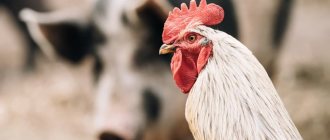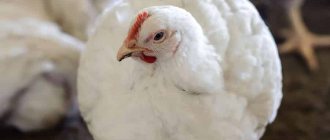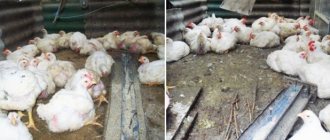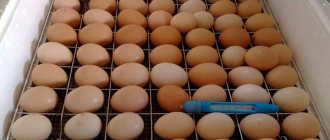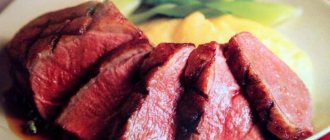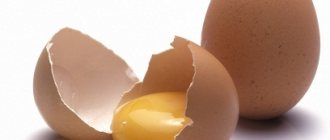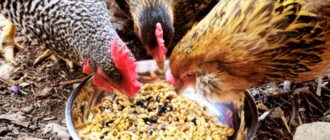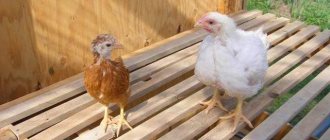The optimal time for slaughter of livestock depends on how long the broiler grows for meat. Receiving meat products in a short time depends on high-quality feeding and care of the poultry. Poor hygiene, lower temperatures and protein deficiencies will affect the health of broilers. And the farmer will receive an unprofitable business instead of profit. To increase production efficiency, it is recommended to use special tables and weigh chickens to adjust the diet.
Benefits of keeping broilers
Previously, there was no targeted selection of broiler chickens in order to obtain meat carcasses in a short period of time. But thanks to breeding work, multiline crosses have been developed that are adapted to cellular maintenance and the systemic delivery of compound feed.
The key to success is choosing a special cross. The benefit of backyard rearing is that the chickens gain 2.5 kg in weight before 6 weeks. After 50 days, hens reach 3 kg, and cockerels about 5 kg.
Study in detail the advantages of the chicken meat line in the article “Evaluation of broiler farming as a business: profitable or not.”
What not to feed
Healthy broiler chickens have an excellent appetite, so they will eat whatever is offered to them. But this does not mean that they are allowed to give everything: some foods can cause digestive and health problems.
You cannot feed broilers with low-quality food: spoiled, moldy or rotten. Also, you should not give them raw potatoes, which may contain solanine. This substance can cause poisoning and even death of birds, so you should not take risks.
It is also not recommended to feed beet roots and tops - they have a laxative effect. In broilers, the vegetable can cause diarrhea. There is no need to feed fatty or sweet kitchen scraps or fruits to fattening birds: they lead to the accumulation of fat and not muscle mass, as needed.
Popular broiler crosses
What is this
The term “broiler” does not mean a specific breed, but young meat crosses, specially fed to a marketable carcass.
More often, broilers are called hybrid lines from crossing Langshans, Plymouth Rocks, Cochins and other breeds.
Let's look at brief characteristics of common types.
Broiler-M
It is considered a universal cross. Hens fatten up to 2.8 kg, roosters about 3 kg.
After 5 months, chickens begin laying eggs, producing 160 eggs per year.
Broiler-61
Refers to a four-line cross. Plymouthrocks were used for crossing with Cochins. By 6 weeks after hatching, each chick has grown to 1.8 kg.
The advantages include high quality meat, rapid weight gain, and survival rate compared to other broilers.
But building up mass becomes the scourge of cross-country training - problems with bones begin. Therefore, it is advised to adjust the diet of young animals.
ROSS-308
With proper fattening, broiler chickens gain 2.5 kg up to 6 weeks of age.
During the day, the young animals become 55 g heavier, which is considered an indicator of a properly formulated diet.
ROSS-708
They are characterized by rapid weight gain. Already after the first month of life, they grow about 2.5 kg.
The only drawback is that buyers do not really like the whitish skin, which is explained by the rapid growth of chickens.
Gibro-6
Young broilers gain 30 g of weight every day, which translates to 1.5 kg of broilers at 1.5 months.
The bird is covered with white plumage and shows sufficient egg production - 160 eggs. A commercial quality carcass with yellow skin is obtained. But when growing, they monitor the diet because of the fragility of the bones.
COBB-500
It is recommended to feed intensively in the first month of life. The advantages are considered to be insignificant expenses on feed and sufficient survival of young animals.
Chickens in a flock develop equally. An increase of up to 2.5 kg is obtained within 40 days.
Change
A highly productive cross, giving an increase of up to 40 g per day. About 140 eggs are obtained from laying hens during the egg-laying period.
The young are considered resilient. Although it is recommended to keep the livestock after hatching in a warm poultry house with additional heating.
conclusions
The carcass with the yellowish skin of the COBB-500 cross is considered the most attractive for sale. It is obtained without adding corn grain or food additives to the diet of young animals.
Read the detailed description of KOBB-500 and other popular broilers in the article “About broiler chickens: what they are and which ones are better.”
Raising broilers for meat is available to every farmer. Of course, if you know how long a chicken grows to reach its optimal weight.
During the first 20 days, chickens produce maximum growth. Over the next 3 weeks, the diet, temperature and hygiene of the poultry house are monitored to further increase the weight of the chickens before slaughter.
After broilers reach 3 months, their maintenance becomes impractical due to growth inhibition and increasing feed costs.
Which model is better to use?
To breed broilers on your own plot, you do not need a lot of initial capital, but there is a need to study the issue of breeding such animals. Experienced poultry farmers do not recommend starting with large volumes.
It is recommended to experiment with several individuals as an initial experience, as well as to gain information about your own capabilities, costs and features of keeping such a bird.
Did you know? Modern Canadian scientists (University of Alberta) simultaneously raised three breeds of broilers, popular at different times: in 1957, in 1978 and modern. The modern breed has demonstrated a rate of weight gain that is 4 times higher than that of its predecessors in the 50s, while they eat one and a half times less food. This incredible property is acquired due to the lengthening of the intestines and, as a result, better digestibility of food.
You should start with the acquisition of future meat giants:
- in the form of eggs for their subsequent incubation;
- one-day-old chicks for rearing;
- grown, older chickens.
Purchasing and incubating eggs
It makes sense to buy meat hybrid eggs for incubation when you plan to constantly breed broilers. Incubation requires appropriate equipment, which costs a lot of money.
If the poultry farmer already has it, purchasing eggs will be the most preferable way to acquire livestock, since eggs are the cheapest.
This model, however, has certain risks:
- eggs may be defective or expired;
- the resulting breed may not meet expectations;
- The mortality rate of chickens with this method of breeding is the highest.
You can minimize risks only by purchasing goods from a trusted supplier.
Buying day old chicks
Having decided to purchase day-old chicks, you should take care in advance of their proper transportation, because the chicks are very vulnerable. This model is the most common, although it is much more expensive than the previous one.
Did you know? Breeding broilers is not a genetic modification, but the result of selection, which turned out to be possible only in poultry. In fact, this phenomenon is evolution, recreated artificially and having a negative result. Indeed, in living nature such individuals would not have a chance to survive: they have low immunity, problems with the musculoskeletal system, myopathies, metabolic disorders, and so on.
But in this case, the poultry farmer can calculate his future expenses and profits based on the available livestock. There is some risk of death of the purchased bird, most often due to maintenance errors.
Change in weight of broiler chickens with age
Up to 10 days
The secret to growing massive birds is considered to be the skill of the poultry farmer. Particular attention is paid to caring for young animals in the first month of life.
The weight of the hatched chick is about 50 g, with deviations of 1-2 g. The first weighing provides the prerequisites for determining which broilers will gain more weight in the future. Even an excess of 2 g in a chicken will allow one to judge the growth of a large marketable carcass.
Feeding with prestarter feed makes it possible for each bird to gain up to 200 g in the first ten days. This approach has a beneficial effect on the digestive tract, absorption of nutrients and building muscle mass.
Regular food is not able to saturate the body with the necessary components, and the farmer will not be able to raise a large meat chicken.
After 10 days
From ten days of age, young animals are transferred to adult poultry feed in order to save money on feeding. By 14 days, the weight of each chicken should reach 0.5 kg. After which the livestock gains weight more slowly.
The average weight of a month-old broiler is up to 1.5 kg. But in this case, the mass of the bird depends on its belonging to the cross.
Poultry farmers prepare chickens before slaughter, obtaining tender meat with high taste values, valued on the market. Although up to 2 months the young animals reach only 3 kg, further maintenance becomes unprofitable.
Business profitability
Before you start calculating profits, you need to take into account exactly how much you will have to spend at the starting stage and in the future when keeping broilers. The main items that will require the greatest investment are summarized in the table.
Table 3. Costs of raising broiler chickens
| Expense line | Cost (thousand rubles) |
| Construction of a permanent poultry house | 70 – 150 |
| Documenting | 15 |
| Purchase of equipment | 30 |
| Stern | 10 |
| Chicks | Eggs – 0.03; chicken – 0.1 |
To avoid losses, slaughter broilers in a timely manner
Thus, the business has an average profitability with large production volumes. They are low if the population is less than 100 individuals. Since there are few problems with chicken, and the bird itself is quite calm, for many, broiler breeding becomes the main source of income.
Having your own farm store will reduce costs, since large companies require a minimum price and a large number of documents. To obtain permission to sell, you will have to obtain a veterinarian's opinion, but it will be possible to sell not at a wholesale price, but at a retail price.
Control weighing of young animals
It is important
To determine how long broilers grow before reaching the desired weight for slaughter, it is recommended to weigh them periodically.
To help farmers, a special table has been developed indicating the growth of broiler chickens by day, presented in the article “How much does a chicken weigh on average?”
All that remains is to start weighing. And here it is recommended to use scales or a canter. Meat chickens have a phlegmatic character, so even a beginner will not have a problem finding out their weight.
Weighing techniques
Using scales. It is advisable to have a bag with a lid on hand. First, place the bag on the scales and remember the weight. It is advisable to carefully place the broiler in the weighing bag. It remains to subtract the weight of the empty bag from the resulting value to find out the mass of the bird. The technique is used for large individuals.
Using a canter. Place the broiler in a thick gauze bag. Make sure that it does not accidentally burst under its weight. Hang the bag to the canter, slowly lift it, and look at the indicators.
Deviations in weight to a lesser extent become a reason to revise the diet of young animals.
The procedure of weighing chicken only at first seems difficult, but later it will help to raise productive livestock with large weights. And there will no longer be any confusion about how long chickens grow before slaughter.
Poultry meat yield:
The output of deboning broiler chickens with an emphasis on the production of boneless breast meat.
name of raw materials
Percentage of yield to weight of broiler chickens, %
Frames (including soup set)
Deboning of broiler chickens with the production of all semi-finished poultry meat products on the bone.
name of raw materials
Percentage of yield to weight of broiler chickens, %
Frames (including soup set)
When cutting broiler chickens, the frames could be sorted into a soup set as a ready-made semi-finished product, or chicken frames could be used for the production of mechanically deboned poultry meat.
Technological losses in a decent amount during deboning of poultry meat are due to the loss of meat juice and raw fat.
When deboning broilers, average data were obtained on the time consumption for deboning 100 kg of raw materials in the first case, the average value is 1 hour 10-20 minutes, in the second case around 1 hour.
Poultry is often bred solely for its meat. In this case, fast-growing chickens are used.
To raise them, it is important to weigh chickens frequently, record the results, compare them with the daily broiler weight table in order to draw conclusions about the rate of development, and timely implement measures to correct the diet if poor weight gain is observed.
Causes of inhibition in development
General
If purebred chickens are immune to most diseases, then meat crosses are demanding in terms of housing conditions and a special diet.
Beginning poultry farmers are often faced with the problem of broilers lagging behind in development, diseases and mortality.
It is necessary to dwell in detail on the mistakes that lead to the disappointment of farmers and the refusal to raise broilers.
Weight Loss Factors
A specific line of crosses. Among the many meat lines, varieties with fast and slow weight gain have been bred. Perhaps the poultry farmer purchased a cross that grows slowly, but later gains weight.
Dietary disorder. Meat chickens need increased amounts of protein in their feed. And without amino acids they will not build muscle mass.
Dysfunction of the gastrointestinal system. Immediately after birth, young animals need to be fed with special feed. If the conditions are not met, dispersion develops. Another cause of frustration is the distribution of moldy food.
Large walking area. Broilers are bred to be kept in cages, and walking does not promote weight gain. It is recommended to transfer the livestock to cramped conditions at the rate of about 0.5 m2 of area per 10 chickens.
Other circumstances
Keeping at low temperatures. Cold becomes another reason for weight loss in young animals, who spend energy on heating the body.
Gas pollution in the room. Lack of ventilation leads to poisoning of livestock and reduces weight gain.
Diseases and parasites. If chickens are rapidly losing weight, there is a reason to examine the flock for helminth infection.
In order to prevent diseases, it is recommended to regularly feed young animals with vitamins and a slightly pink solution of potassium permanganate.
It is common practice in poultry farms to feed broilers antibiotics and growth stimulants. The livestock quickly gains weight and is not susceptible to disease.
In order to grow a healthy herd, common mistakes are eliminated.
Methods for solving the problem
Broiler chickens grow well if kept in good conditions and given adequate nutrition. Having discovered smaller deviations from the norm during control weighing of chickens, it is necessary first of all to correct the birds’ diet. Next, we will have to work to improve the living conditions of birds.
Broiler nutrition
When raising meat chickens, it is better to feed them ready-made feed, selecting it according to age. It will contain the necessary substances in the correct proportion. If the farmer prepares the mash himself, then it is worth adding premixes and vitamins to their composition. The broiler diet should include:
- protein - it is found in grains, eggs, cottage cheese, fish, legumes;
- vegetables – carrots, fodder beets;
- greens - nettles, onions, tops;
- mineral supplements - chalk, shell rock, yeast, bone meal, fish oil.
It is important to properly organize the feeding of chickens. Chickens under 7 days old are given food 8 times a day at regular intervals. From the second week of life they are transferred to six meals a day, then to four meals a day.
From the second week of life they are transferred to six meals a day, then to four meals a day.
Important! The transition to a new type of feed is being made gradually. A sudden change in diet causes stress in birds; they need to get used to the new taste and composition of food
Correction of conditions of detention
The poultry house must be warm. The temperature inside, even in winter, cannot fall below +20 degrees. In the fall, it is worth sealing all the cracks and considering the possibility of heating the room. The presence of ventilation is a mandatory requirement. Harmful vapors of hydrogen sulfide and ammonia, damp and musty air have a detrimental effect on the health of birds.
It is extremely important to organize proper lighting of the poultry house. Experienced poultry farmers recommend using infrared lamps; their light has a soft reddish tint. In addition, these lamps give off heat well
In addition, these lamps give off heat well.
It is important to keep the chicken coop clean by regularly removing droppings. Complete disinfection of the premises is carried out twice a year. Drinkers and feeders are washed with soda solution or scalded with boiling water daily
All these measures will help avoid the spread of infectious and parasitic diseases.
Drinkers and feeders are washed with soda solution or scalded with boiling water daily. All these measures will help avoid the spread of infectious and parasitic diseases.
Reduced walking
If birds receive feed in the required quantity, and their housing conditions meet sanitary standards, but there is a lack of weight, it means that the birds move a lot. It is beneficial for chickens of meat breeds to be outdoors and take sunbathing, but walks should not be long. It is better to reduce the area of the yard to a minimum - there should be 18–20 chickens or 10 adult birds per 1 m2.
Broilers do not grow or gain weight slowly for three reasons - due to an incorrect diet, poor living conditions or an active lifestyle. When faced with a problem, a farmer must analyze where he made a mistake and try to change the situation as quickly as possible, because his profit depends on it.
Tips for gaining weight
Content adjustment:
- Equipment for an insulated poultry house. The herd is kept on a thick layer of bedding or in cages. It is highly undesirable to equip a walking yard where the bird feels uncomfortable.
- Remove damp bedding regularly to prevent mold from growing on the floor. High humidity causes indigestion.
- The air temperature during the first week of chickens’ life should not fall below +30°C. As the livestock matures, the indicators are reduced to +20°C.
- The lights in the room are never turned off. It is advisable to use dim light and paint the lamps red to avoid outbreaks of cannibalism.
- The poultry house is promptly cleared of excrement and internal surfaces and equipment are disinfected.
- The bird is sensitive to ammonia fumes, so ventilation or vents are installed to ventilate toxic substances.
- Place basins with an ash-sand mixture for bathing chickens. This is how they get rid of parasites on their own.
If the housing conditions are met, and the chickens look sick, it is advisable to introduce food additives into the diet. For example, Chiktonik, the use of which is described in the article “Instructions for using Chiktonik for chickens.”
Nuances of breeding
In order for the chicks to actively gain weight and not get sick, it is important to create comfortable conditions for them - only then will the farmer be able to receive maximum income. Among the requirements for keeping broiler chicks, we note the main ones:
- the room should not contain windows, and the possibility of drafts must be prevented, but air circulation must be good, so it is recommended to install a hood. Before moving the young animals in, it is worth disinfecting them. The floor should have a bedding of wood shavings;
- The density of keeping birds per 1 square meter depends on their weight. It must be taken into account that this area would account for no more than 40 kilograms of the live weight of the chicks. Therefore, at first you can keep quite a few chicks, and then they will need to be gradually seated. It is not recommended to keep several broods in one place, as this will increase the likelihood of an epidemic developing. It is better to make partitions for each offspring separately. If chickens are kept in cages, then in an area of 1 sq.m there should be no more than 18 young and 9 adults;
- For the first 2 weeks, lighting is provided around the clock, then it is turned off for an hour, leaving only in the area where the chicks live. Also, the place where the drinking bowls are located should be illuminated;
- Feeders and drinkers should be installed according to the number of individuals to prevent the possibility of them fighting for survival and causing injury to each other.
These are the basic rules that a farmer must follow when breeding broiler chickens.
The relationship between nutrition and weight gain
Advice
Crosses are specially created for producing marketable meat carcasses. And in order for broilers to grow quickly, they provide the livestock with complete feed, proteins, vitamins and microelements.
It is recommended to use a scheme for raising young animals, which includes four fattening periods.
First
The pre-launch period falls on the first week of broiler life. Feed is given 8 times a day, at the rate of 20 g of food for each chicken.
In addition to pre-start feed, chopped boiled eggs, oatmeal, and low-fat cottage cheese are fed. Weight gain per day is at least 15 g. At the end of the first stage, the weight of the chickens is about 115 g.
Second
The starting period starts from 6 to 20 days. Reduce the number of feedings to 5 per day. But they increase the portion from 50 to 80 g per chicken.
Weighing shows a weight gain of at least 30 g per day. By the end of the period, young animals weighing 650 g are obtained.
It is allowed to feed ad libitum, bringing the amount of corn to 45% of the total feed. The young animals are given grated carrots and pumpkin, greens, bone, fish and grass meal, yeast, meal, and animal fat.
Third
The fattening stage lasts up to 40 days. With proper feeding, the bird gains about 55 g per day. Therefore, chickens at the final stage weigh 2.1 kg.
Each bird is given 150 g of feed 4 times a day, feeding the young with boiled potatoes, fish, yeast, grain crops, chalk and premixes.
Fourth
At the final stage before slaughter, each broiler is given 170 g of feed twice a day. They provide food in abundance, switching the livestock to whole grains, green mass and succulent feed. Feeding allows you to get carcasses of 2.5 kg.
To gain weight, it is recommended to ensure the supply of microelements and minerals, and not to skimp on high-quality feed and vitamin supplements.
Detailed recommendations for preparing a diet are described in the article “Feeding standards for broilers.”
Fattening rules
The standard scheme for raising meat chickens involves the use of three diet options, taking into account age:
- Designed for young animals during the first 5 days of life.
- Applied at the next stage, until the chickens reach the age of 1 month.
- The final one, which will form the basis of the menu for adult broilers, right up to slaughter.
Up to 5 days
Chicks in the first days of life are fed at intervals of 2 hours. They are given:
- hard-boiled, chopped egg mixed with semolina;
- cottage cheese with corn grits.
For 10 broilers you need 1 egg, 50 g of cereal and the same amount of cottage cheese. As a supplement you can feed:
- ground oatmeal with dry milk in a ratio of 4:1;
- ready-made feed for chickens.
Drinkers with fresh water should always be freely available.
For the first 5 days, babies need up to 15 g of feed per head. After 10 days, its quantity is increased to 20 g, and in the next 10 days - to 45 g. Then the volume of feed mixtures increases by 15-20 g every 10 days. As a result, by 2 months the bird consumes 115-120 g. Knowing the nutritional standards and the number of livestock, you can calculate the required amount of feed for the entire chicken coop.
From 6 days to 1 month
At the end of the first week the following is added to the menu:
- mash with yogurt or broth;
- waste from meat and fish.
From the 10th day they give:
- boiled potatoes with grain;
- chopped pumpkin, as well as carrots and zucchini.
Wet mash is prepared immediately before feeding, and birds should eat it within 40-50 minutes. Leftovers should be removed as they sag quickly and can cause digestive upset in chickens.
Fermented milk products in their pure form are very beneficial for chickens. They are given in the morning, after which the drinking bowls are washed and filled with water. To prevent intestinal infections, birds are fed a pale solution of potassium permanganate twice a week.
Starting from one and a half weeks, young broilers are transferred to 6 meals a day and given mineral supplements:
- crushed chalk;
- crushed egg shells.
To stimulate digestion, place coarse sand in separate bowls.
During the second stage of fattening, broilers are prepared with combined formulations from the following components:
- corn and soybeans;
- poppy seed and wheat;
- yeast and premix for chickens.;
- meat and bone (fish) and herbal meal;
- crushed shell;
The grain is given crushed. To ensure that the chicks peck the entire food, and not its individual components, the composition should be mixed well.
If birds scatter food around while eating, it is recommended to adjust the height of the feeders. In the first three weeks they are placed directly on the floor (bedding) and then raised.
| Chick age (weeks) | Feeder installation height (from the floor) |
| 4 | 0.1 m |
| 5 | 0.14 m |
| 6 | 0.18 m |
| 7 | 0.2 m |
| 8 and older | 0.23 m |
The edge of the side of the feeder should be at the level of the chicken's back, and the container should be no more than 1/2 full of grain.
From 15 to 30 days of life, chickens undergo active skeletal growth and muscle formation. During this period, broilers are transferred to 4 meals a day, as the volume of food consumed increases. Feeds should be varied and high in calories. A grown-up meat chicken with proper development by the end of the 1st month has a noticeable massive chest, and rounded hips are shaped like hemispheres. At this age, the average weight of a bird is from 1.5 to 2 kg.
Finish fattening
The final stage of fattening lasts from 30 to 45 days. Its goal is to maximize body weight gain. To ensure high weight gain, base mixtures are formed based on:
- 45% corn grain;
- 10% - barley;
- 16% - wheat;
- up to 17% sunflower seed;
- 5% fish or meat and bone meal;
- 5% feed yeast;
- 1% vegetable oil.
By the age of 1.5 months. broilers living in cages weigh 2.5-3 kg. When kept outdoors, they can gain this body weight 10-14 days later. Poultry weighing 2 kg or more is considered ready for slaughter. After 45 days, the intensity of muscle mass building in broilers decreases, so their further maintenance becomes economically unfeasible.
Benefits of feeding with compound feed
Meat crosses quickly gain weight in a short time. Therefore, you should provide them with a high-calorie diet rich in vitamins and nutrients for development.
Without the provision of complete, balanced feed, it is not possible to obtain marketable carcasses in a short time.
More often, farmers purchase ready-made combined mixtures in production. But it’s cheaper to make your own feed, using the advice from the article “Types and composition of feed for broilers.”
Basic rules of fattening
The acceleration of the growth of broilers is determined by the normal conditions of their keeping, as well as by a complete, balanced diet. Nutrition is provided first according to a frequent schedule, and then, as the chickens grow, the number of their feedings decreases, so it is important to know the approximate age of the livestock. A farmer does not always raise poultry from birth, but you can determine the age of broilers by external signs:
- one week - by this age the chicken’s wings have grown to the tail, but they still remain covered with down;
- 12 days – the chickens’ shoulders are covered with feathers;
- by 19-21 days of life, the crop, back and breast are covered with feathers. feathers on the tail begin to grow;
- at 4-5 weeks the first molt occurs, after which flight feathers appear on the wings;
- within 6 weeks the head and lower part of the body feather;
- By 3 months, the broiler has full plumage, which is ready to shed in the fall.
Considering the age of the broilers, you can adhere to the following feeding scheme, while not forgetting to weigh the birds.
The first 5 days after birth. This age requires maximum attention and care for weak chickens. Such babies should be fed at least 8 times a day (including at night) after an equal amount of time. Their diet should consist of 25% protein, which comes from boiled yolk, cottage cheese and corn grits. Food should be well ground.
The drug “Trivit” is a health and growth stimulator for chickens; it is better to give it in a course - 1 drop 4 times every 7 days. Weak chicks are temporarily kept separately from the rest of the population until they get stronger.
- 6-10 days. Gradually introduce roughage, cereals, and greens. The frequency of meals is 7-8 times, including one night feeding. You can give grated fresh carrots, at first no more than 5 grams per head, then increasing this amount to 20-25 if the chickens’ reaction was normal.
- Closer to 10 days of age, it is useful to introduce lime, shell rock, and small eggshells.
- 11-20 days. Nutrition is already reduced to 6 meals per day. It is good to mix bone meal into the diet and give boiled fish waste. Curdled milk or skimmed milk will improve the microflora of young animals.
21-30 days. The most important milestone when raising broilers, the weight of which must comply with the standards. The cereals are mixed with boiled crushed potatoes, and the broilers peck at the whole grain. Meals – 5-6 times a day. After 30 days, the bird can be completely transferred to an adult diet with 4 feedings a day before slaughter
It is important to add vitamin premixes to food, taking into account the dosage, and carefully monitor the health of the livestock
Throughout the entire growing period, weight gain must be monitored, if not daily, then at least weekly. This procedure makes it clear whether the bird is sick or whether mistakes are being made in the nutrition and maintenance of broilers.
You can learn how to raise broilers from the video.
Broiler is a meat breed of poultry in farmers' households. The most popular hybrids are:
The broiler reaches its maximum weight after 3 months. For this reason, the breeder weighs the chickens daily, controls their weight and calorie content of the feed. This way you can correct shortcomings in growth and get closer to the norm. A broiler growth chart will help you control weight gain.
How long do they grow before slaughter?
It is not advisable to keep broiler chickens for more than 3 months. The livestock stops gaining weight by consuming large amounts of feed.
Find out the exact volumes of feed in the article “How much feed does a broiler need before slaughter.”
The farmer will face unjustified costs due to a decrease in the quality of meat. Broilers become overgrown with fat, the meat becomes fibrous and tough.
Dry food or mash
To ensure good weight gain in chicks, it is important to feed them both dry feed and mash. Granular food is chosen as a dry mixture.
The mash consists of milk, feed and whey. Meat broth is also used. For every kilogram of dry food, chickens are given 500 ml of liquid. The mash quickly turns sour. This needs to be monitored: an hour after eating, all feeders are cleaned.
Alternating dry food and mash is the best option. The first one should always be in the feeders.
Egg incubation
With the reduction in the number of poultry in poultry farms, it is not always possible to purchase day-old broiler chicks. In this regard, before raising young animals for meat, homestead owners get adult birds or raise them until sexual maturity. Hatching eggs are then .
The industry produces small-sized incubators specifically for private farms. Domestic manufacturers produce models: IPH-5, IPH-10, LEO-0.5, “Nasedka” and others. They contain 50-100 eggs.
But working with an incubator is a complex process that requires special knowledge, strict adherence to the technology of raising broiler chickens and the purchase of expensive equipment.
For incubation, eggs are carefully selected based on shape, weight, egg contents and shell condition. For breeding young meat animals, culling is less strict.
During the incubation process, process parameters are monitored : readings of wet and dry thermometers, opening of dampers, rotation of trays, operation of fans. Despite the fact that the incubation mode is maintained automatically, instrument readings are checked every 8 hours and the operation of the device is monitored.
You can read about the life expectancy of rabbits here. This is interesting!
Salmonella
This nasty disease also sometimes affects broilers. Mostly young animals suffer from it. Symptoms may include swollen eyes and legs, diarrhea, and lack of appetite. Since salmonellosis is a contagious disease, infected birds should be immediately removed from the main flock, and the remaining broilers should be given chloramphenicol, dissolved in water. Chickens are treated for salmonellosis with streptomycin or furazolidone. In any case, it is worth calling a veterinarian.
Keeping broilers, therefore, is a serious matter, troublesome and quite time-consuming. Such a business will be profitable only if the bird receives maximum attention from the owner. In particular, it is worth taking a responsible approach to compiling the diet of chickens, as well as preventing the spread of various types of infections in the barn.
Living conditions
To breed broilers you do not need any special knowledge. If you decide to start raising broilers at home, you must keep the birds in certain conditions. Caring for broilers is different from keeping regular chicken breeds.
Place. From the first day of life, chickens need to arrange a place. Broilers can be kept on litter or in cages. Litter (sawdust or other dry, loose mass) should be no more than 10 cm. It is allowed to contain no more than 18 heads per square meter.
It is important to maintain the temperature at 26–33 °C in the first 5–7 days of life, and then gradually reduce the temperature to 19–18 °C. The room must be illuminated 24 hours a day. The light is dim, in the first seven days the lamp power should be 1.8 W per square meter, then until the 7th week of growth - 1.2 W and at the finish line you can use a lamp of 0.6 W
Too bright light can cause pecking. The lamp lamp can be painted green or red
The light is dim, in the first seven days the lamp power should be 1.8 W per square meter, then until the 7th week of growth - 1.2 W and at the finish line you can install a lamp of 0.6 W. Too bright light can cause pecking. The lamp lamp can be painted green or red
The room must be illuminated 24 hours a day. The light is dim, in the first seven days the lamp power should be 1.8 W per square meter, then until the 7th week of growth - 1.2 W and at the finish line you can install a lamp of 0.6 W. Too bright light can cause pecking. The lamp lamp can be painted green or red.
Broilers need cleanliness and constant care
Maintaining cleanliness. You need to constantly monitor the cleanliness of the room where broilers grow. Clean regularly and change the litter. To prevent gastrointestinal infections in poultry, drinkers and feeders should be washed with hot water.
Choosing the optimal breed
Almost all broiler crosses are the result of hybridization of highly productive meat chickens. They have a strong skeleton and in most cases white plumage. The average daily weight gain of chickens is 80 g. The most productive broiler breeds include:
- ROSS-308 and 708;
- COBB-500;
- Hubbard F-15;
- Gibro-6;
- Broiler-61.
Among owners of private farms, birds from the Smena line are very popular. When choosing a specific breed, it is recommended to focus on its productivity indicators, adaptability to the climate of your region and the cost of chickens.
Answers to common questions
Slaughter can be carried out on the 50th day, less often - on the 70th day. By this time, the net weight of the chicken will be 3.7 kg. The largest ones reach 5 kg
In this case, it is important to wait for the bird to plumage, otherwise plucking will be more difficult and longer. As a result, there will be no feathers that are difficult to pull out, and the broiler will fledge faster this way
The carcass will be cleaner, without the smell of droppings. If chickens are outside more often, there will be more muscle and meat.
Broiler weighing
Ross-308, Ross-708, Koob-500, Hubbard cross are meat breeds. These birds are distinguished by rapid weight gain, calm disposition and heavy weight. Some individuals reach 5-6 kg. The only drawback is that broilers lay few eggs.
A specially equipped chicken coop is built for breeding chicks.
What is important for development and weight gain:
- temperature not lower than 30 degrees,
- 24-hour lighting in the first weeks of chicks’ lives,
- diet depending on age.
Under ideal conditions, chickens reach a weight of 1.6 kg in the first month, by the end of the second month the weight reaches 2.7 kg. By the time of slaughter, the broiler weighs from 3.7 to 5 kg.
Common Mistakes
Errors in the maintenance of broilers lead to the fact that individuals die or stop growing. The main thing is to prevent rotting of the litter. Mold forms on it if drinkers and feeders are placed on a layer of sawdust.
It is necessary to constantly clean the premises and cages of droppings. In this case, it is worth disinfecting the walls and floors and drying them to prevent the development of diseases.
When the nutrition of broilers is not balanced, it contains few vitamins and microelements, then the birds begin to peck at each other’s heads. Weak specimens suffer the most from attacks.
Young animals must be fed at the same time. Don't forget about clean warm water. Broilers often die due to dehydration.
Thanks to mandatory vaccination, all birds can be saved if symptoms of the disease appear in some individuals.
A profitable business will be successful when you properly engage in broiler farming.
How to grow using an incubator
Eggs no older than 3 days are suitable for raising chickens in an incubator. Before placing them in the device, you need to adjust the temperature mode:
- First week. Optimal mode +38.5…+39 degrees. After placement, the eggs must warm up for a day, after which they are turned. Then they move regularly (those from the sides are moved to the center and vice versa).
- From day 19 there is no need to turn over. The temperature should be +37 degrees.
- On the 20th day the chicks will appear. On day 22 they can be pulled out of the incubator.
Expert opinion
Firsov Sergey Arkadevich
Poultry farmer
Note! For hatchery chicks, you need to arrange dimmer lighting.

